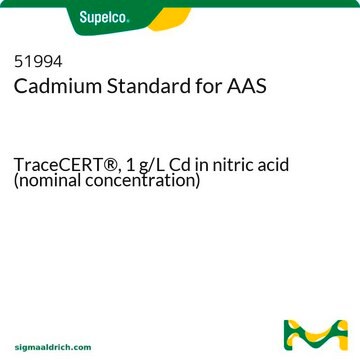If this product has an expiration or retest date, it will be shown on the Certificate of Analysis (COA, CofA). If there is no retest or expiration date listed on the product's COA, we do not have suitable stability data to determine a shelf life. For these products, the only date on the COA will be the release date; a retest, expiration, or use-by-date will not be displayed.
For all products, we recommend handling per defined conditions as printed in our product literature and website product descriptions. We recommend that products should be routinely inspected by customers to ensure they perform as expected.
For products without retest or expiration dates, our standard warranty of 1 year from the date of shipment is applicable.
For more information, please refer to the Product Dating Information document: https://www.sigmaaldrich.com/deepweb/assets/sigmaaldrich/marketing/global/documents/449/386/product-dating-information-mk.pdf
270393
Tetracloroetileno
suitable for HPLC, ≥99.9%
Sinônimo(s):
PCE, Percloroetileno
About This Item
Produtos recomendados
grau
HPLC grade
Nível de qualidade
densidade de vapor
5.83 (vs air)
pressão de vapor
13 mmHg ( 20 °C)
19 mmHg ( 25 °C)
Ensaio
≥99.9%
Formulário
liquid
purificado por
glass distillation
técnica(s)
HPLC: suitable
Impurezas
<0.050% water
resíduo de evaporação
<0.0005%
cor
APHA: ≤10
índice de refração
n20/D 1.505 (lit.)
p.e.
121 °C (lit.)
pf
−22 °C (lit.)
densidade
1.623 g/mL at 25 °C (lit.)
λ
H2O reference
Absorção UV
λ: 290 nm Amax: 1.00
λ: 295 nm Amax: 0.30
λ: 300 nm Amax: ≤0.20
λ: 305 nm Amax: 0.10
λ: 350 nm Amax: 0.05
λ: 400 nm Amax: 0.03
aplicação(ões)
food and beverages
cadeia de caracteres SMILES
Cl\C(Cl)=C(\Cl)Cl
InChI
1S/C2Cl4/c3-1(4)2(5)6
chave InChI
CYTYCFOTNPOANT-UHFFFAOYSA-N
Procurando produtos similares? Visita Guia de comparação de produtos
Categorias relacionadas
Aplicação
- Microextração líquida-líquida dispersiva como uma nova abordagem de enriquecimento para análise de isótopo de carbono específico do composto de fenóis clorados.: Este estudo introduz uma nova técnica de microextração envolvendo tetracloroetileno, aumentando a sensibilidade e a especificidade da análise do isótopo de carbono em amostras ambientais complexas (Martin et al., 2024).
- Síntese one-pot de foto sob demanda in situ de ésteres de carbonato de tetracloroetileno.: Esta pesquisa apresenta um novo método fotoquímico para sintetizar ésteres de carbonato de tetracloroetileno, demonstrando seu potencial na química orgânica sintética e aplicações industriais (Higashimura et al., 2024).
Palavra indicadora
Warning
Frases de perigo
Declarações de precaução
Classificações de perigo
Aquatic Chronic 2 - Carc. 2 - Eye Irrit. 2 - Skin Irrit. 2 - Skin Sens. 1 - STOT SE 3
Órgãos-alvo
Central nervous system
Código de classe de armazenamento
6.1C - Combustible acute toxic Cat.3 / toxic compounds or compounds which causing chronic effects
Classe de risco de água (WGK)
WGK 3
Ponto de fulgor (°F)
No data available
Ponto de fulgor (°C)
No data available
Escolha uma das versões mais recentes:
Já possui este produto?
Encontre a documentação dos produtos que você adquiriu recentemente na biblioteca de documentos.
Os clientes também visualizaram
-
How can I determine the shelf life / expiration / retest date of this product?
1 answer-
Helpful?
-
-
How is shipping temperature determined? And how is it related to the product storage temperature?
1 answer-
Products may be shipped at a different temperature than the recommended long-term storage temperature. If the product quality is sensitive to short-term exposure to conditions other than the recommended long-term storage, it will be shipped on wet or dry-ice. If the product quality is NOT affected by short-term exposure to conditions other than the recommended long-term storage, it will be shipped at ambient temperature. As shipping routes are configured for minimum transit times, shipping at ambient temperature helps control shipping costs for our customers. For more information, please refer to the Storage and Transport Conditions document: https://www.sigmaaldrich.com/deepweb/assets/sigmaaldrich/marketing/global/documents/316/622/storage-transport-conditions-mk.pdf
Helpful?
-
Active Filters
Nossa equipe de cientistas tem experiência em todas as áreas de pesquisa, incluindo Life Sciences, ciência de materiais, síntese química, cromatografia, química analítica e muitas outras.
Entre em contato com a assistência técnica











